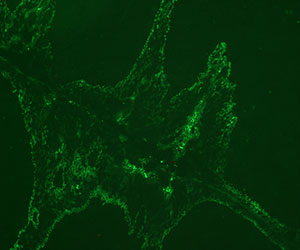CD283 / TLR3 Mouse Monoclonal Antibody [Clone ID: 713E4.06]
Specifications
| Product Data | |
| Clone Name | 713E4.06 |
| Applications | IHC |
| Recommended Dilution | DDX0474P-50 / DDX0474P-100 Purified: FACS intracellular, ImmunoHistoChemistry frozen sections, ImmunoHistoChemistry parrafin sections. DDX0474A488-50 / DDX0474A488-100 Alexa-fluor®488: FACS intracellular, ImmunoFluorescence. DDX0474A546-50 / DDX0474A546-100 Alexa-fluor®546: ImmunoFluorescence. DDX0474A647-50 / DDX0474A647-100 Alexa- fluor®647: FACS intracellular. DDX0474B-50 / DDX0474B-100 Biotin: ImmunoHistoChemistry frozen sections, ImmunoHistoChemistry parrafin sections. Usage recommendation: *This monoclonal antibody may be used between 5-20 μg/ml. *Optimal dilution should be determined by each laboratory for each application. *Coupled antibody: to maintain RT before using. |
| Reactivities | Canine, Human, Mouse, Porcine, Rat, Sheep |
| Host | Mouse |
| Isotype | IgG1 |
| Clonality | Monoclonal |
| Immunogen | Human recombinant TLR3 in eukaryotic cells (pUNO-hTLR3). |
| Specificity | Human TLR3 (intracytoplasmic). Species cross-reactivity: Rat, Mouse, Dog, Pig, Sheep. |
| Formulation | Purified: 100 μg in 200μl / 50 μg in 100 μl Tris-NaCl pH 8. Coupled: 100 μg in 200μl / 50 μg in 100 μl PBS 50% glycerol. Label: Biotin |
| Concentration | 0.5 mg/ml |
| Purification | QMA Hyper D ion exchange chromatography |
| Conjugation | Biotin |
| Background | The Toll-like receptor (TLR) family has recently emerged as key for sensing microbial infections and triggering inflammatory and innate responses. Ten TLRs have been cloned in humans. They share structural and functional homologies, as they are all able to detect micro-organisms through direct recognition of conserved Pathogen Associated Molecular Patterns (PAMPs) such as bacterial lipopolysaccharide (LPS) or viral double stranded RNA (dsRNA). Ligand recognition is mediated through the C-terminal Leucine Rich Repeat region, while signalling involves the N-terminal Toll/Interleukin-1 Receptor (TIR) domain. TLR3 has been identified as a receptor for dsRNA. TLR3 is the only TLR that signals exclusively through the TIR-containing adaptor TRIF (TIR-containing adaptor inducing IFNβ), which activates the transcription factors IRF3 and NFκB, and triggers type I interferon secretion. TLR3 is expressed in various cell types, such as fibroblasts, dendritic cells (DCs), or NK cells. While TLR3 is expressed at the cell surface in fibroblasts, it is mostly found in intracytoplasmic vesicles in DCs. |
| Synonyms | Toll-like receptor 3 |
| Reference Data | |
Documents
| Product Manuals |
| FAQs |
| SDS |
{0} Product Review(s)
0 Product Review(s)
Submit review
Be the first one to submit a review
Product Citations
*Delivery time may vary from web posted schedule. Occasional delays may occur due to unforeseen
complexities in the preparation of your product. International customers may expect an additional 1-2 weeks
in shipping.






























































































































































































































































 Germany
Germany
 Japan
Japan
 United Kingdom
United Kingdom
 China
China




